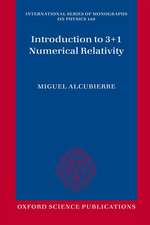The Gravitational Million–Body Problem: A Multidisciplinary Approach to Star Cluster Dynamics
Autor Douglas Heggie, Piet Huten Limba Engleză Paperback – 22 ian 2003
| Toate formatele și edițiile | Preț | Express |
|---|---|---|
| Paperback (1) | 691.22 lei 6-8 săpt. | |
| Cambridge University Press – 22 ian 2003 | 691.22 lei 6-8 săpt. | |
| Hardback (1) | 1369.90 lei 6-8 săpt. | |
| Cambridge University Press – 22 ian 2003 | 1369.90 lei 6-8 săpt. |
Preț: 691.22 lei
Preț vechi: 803.74 lei
-14% Nou
Puncte Express: 1037
Preț estimativ în valută:
132.26€ • 138.47$ • 109.44£
132.26€ • 138.47$ • 109.44£
Carte tipărită la comandă
Livrare economică 05-19 aprilie
Preluare comenzi: 021 569.72.76
Specificații
ISBN-13: 9780521774864
ISBN-10: 0521774861
Pagini: 372
Ilustrații: 85 b/w illus. 5 tables 136 exercises
Dimensiuni: 174 x 247 x 20 mm
Greutate: 0.79 kg
Editura: Cambridge University Press
Colecția Cambridge University Press
Locul publicării:Cambridge, United Kingdom
ISBN-10: 0521774861
Pagini: 372
Ilustrații: 85 b/w illus. 5 tables 136 exercises
Dimensiuni: 174 x 247 x 20 mm
Greutate: 0.79 kg
Editura: Cambridge University Press
Colecția Cambridge University Press
Locul publicării:Cambridge, United Kingdom
Cuprins
Part I. Introductions: 1. Astrophysics introduction; 2. Theoretical physics introduction; 3. Computational physics introduction; 4. Mathematical introduction; Part II. The Continuum Limit: 5. Paradoxical thermodynamics; 6. Statistical mechanics; 7. Motion in a central potential; 8. Some famous models; 9. Methods; Part III. Mean Field Dynamics: 10. Violent relaxation; 11. Internal mass loss; 12. External influences; Part IV. Microphysics: 13. Exponential orbit instability; 14. Two-body relaxation; 15. From Kepler to Kustaanheimo; Part V. Gravothermodynamics: 16. Escape and mass segregation; 17. Gravothermal instability; 18. Core collapse rate for star clusters; Part VI. Gravitational Scattering: 19. Thought experiments; 20. Mathematical three-body scattering; 21. Analytical approximations; 22. Laboratory experiments; 23. Gravitational burning and transmutation; Part VII. Primordial Binaries: 24. Binaries in star clusters; 25. Triple formation and evolution; 26. A non-renewable energy source; Part VIII. Post-Collapse Evolution: 27. Surviving core collapse; 28. Gravothermal oscillations; 29. Dissolution; Part IX. Star Cluster Ecology: 30. Stellar and dynamical evolution; 31. Collisions and capture; 32. Binary star evolution and blue stragglers; 33. Star cluster evolution; Appendices.
Recenzii
'The book contains lucid and concise descriptions of most of the important tools in the subject, with only a modest bias towards the authors' own interests.' Classical and Quantum Gravity
'Enhanced by exercises for the reader, this book is a comprehensive preparation for cutting edge research in the field of stellar dynamics.' Orion
'What they did, covers many aspects of the problem: a historical overview, analytical details for the solvable cases, numerical solutions including computer codes for others, applications for astrophysical examples like star clusters, and a reference list covering twenty pages.' Zentralblatt MATH
'Enhanced by exercises for the reader, this book is a comprehensive preparation for cutting edge research in the field of stellar dynamics.' Orion
'What they did, covers many aspects of the problem: a historical overview, analytical details for the solvable cases, numerical solutions including computer codes for others, applications for astrophysical examples like star clusters, and a reference list covering twenty pages.' Zentralblatt MATH
Notă biografică
Descriere
A 2003 graduate text describing the theory astronomers need for studying globular star clusters.













